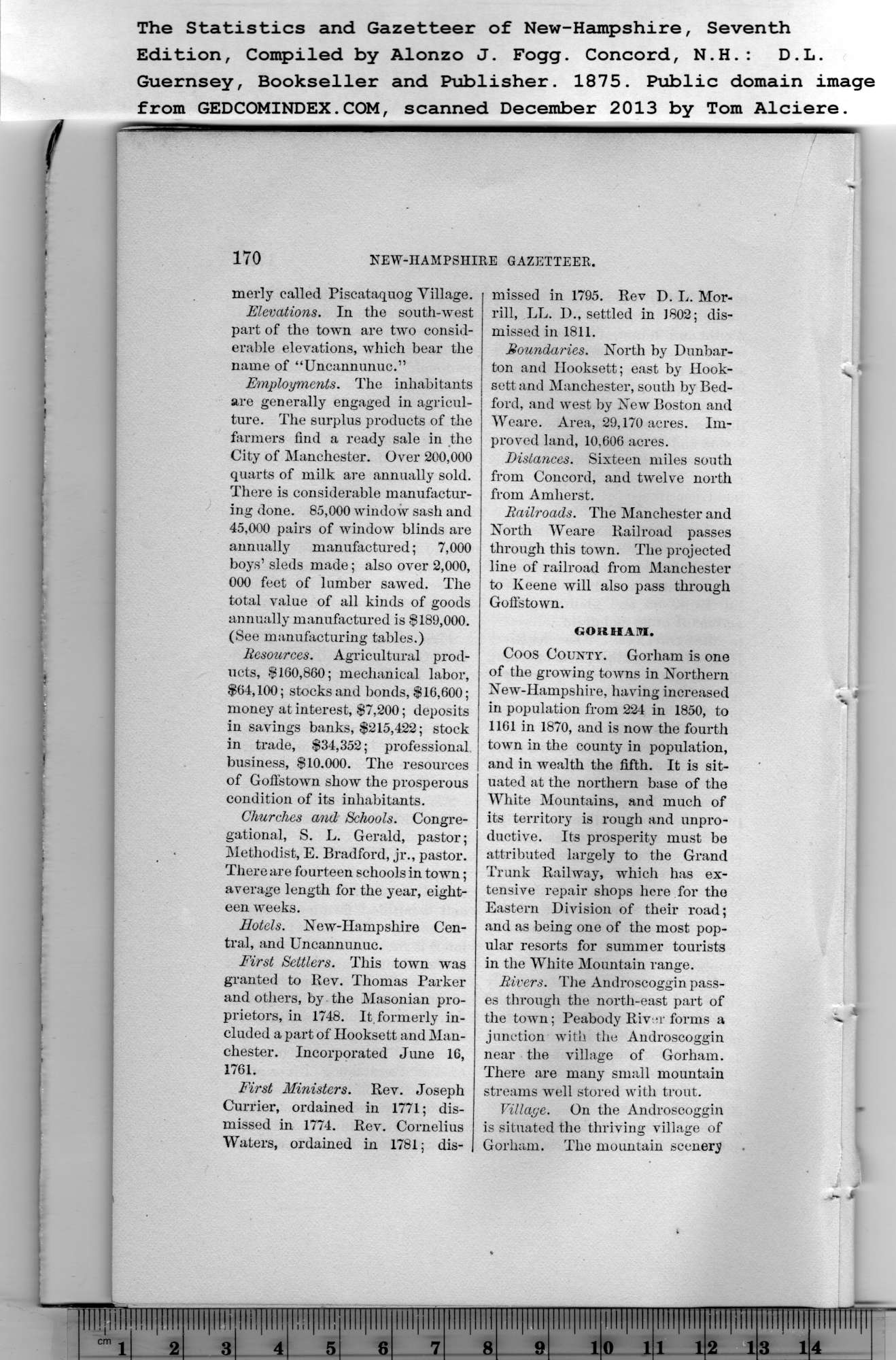|
merly called Piscataquog Village.
The Statistics and Gazetteer of New-Hampshire, Seventh
Edition, Compiled by Alonzo J. Fogg. Concord, N.H.: D.L.
170 NEW-HAMPSHIRE GAZETTEER.
Elevations. In the south-west
part of the town are two consid-
erable elevations, which bear the
name of “Uncannunuc.”
Employments. The inhabitants
are generally engaged in agricul-
ture. The surplus products of the
farmers find a ready sale in the
City of Manchester. Over 200,000
quarts of milk are annually sold.
There is considerable manufactur-
ing done. 85,000 window sash and
45,000 pairs of window blinds are
annually manufactured; 7,000
boys’ sleds made; also over 2,000,
000 feet of lumber sawed. The
total value of all kinds of goods
annually manufactured is $189,000.
(See manufacturing tables.)
Resources. Agricultural prod-
ucts, $160,860; mechanical labor,
$64,100; stocks and bonds, $16,600;
money at interest, $7,200; deposits
in savings banks, $215,422; stock
in trade, $34,352; professional,
business, $10,000. The resources
of Goftstown show the prosperous
condition of its inhabitants.
Churches and Schools. Congre-
gational, S. L. Gerald, pastor;
Methodist, E. Bradford, jr., pastor.
There are fourteen schools in town;
average length for the year, eight-
een weeks.
Hotels. New-Hampshire Cen-
tral, and Uncannunuc.
First Settlers. This town was
granted to Rev. Thomas Parker
and others, by the Masonian pro-
prietors, in 1748. It. formerly in-
cluded a part of Hooksett and Man-
chester. Incorporated June 16,
1761.
First Ministers. Rev. Joseph
Currier, ordained in 1771; dis-
missed in 1774. Rev. Cornelius
Waters, ordained in 1781; dis-
missed in 1795. Rev D. L. Mor-
rill, LL. D., settled in 1802; dis-
missed in 1811. |
Boundaries. North by Dunbar-
ton and Hooksett; east by Hook-
sett and Manchester, south by Bed-
ford, and west by New Boston and
Weare. Area, 29,170 acres. Im-
proved land, 10,606 acres.
Distances. Sixteen miles south
from Concord, and twelve north
from Amherst.
Railroads. The Manchester and
North Weare Railroad passes
through this town. The projected
line of railroad from Manchester
to Keene will also pass through
Goftstown.
GORHAM,
Coos County. Gorham is one
of the growing towns in Northern
New-Hampshire, having increased
in population from 224 in 1850, to
1161 in 1870, and is now the fourth
town in the county in population,
and in wealth the fifth. It is sit-
uated at the northern base of the
White Mountains, and much of
its territory is rough and unpro-
ductive. Its prosperity must be
attributed largely to the Grand
Trunk Railway, which has ex-
tensive repair shops here for the
Eastern Division of their road;
and as being one of the most pop-
ular resorts for summer tourists
in the White Mountain range.
Rivers. The Androscoggin pass-
es through the north-east part of
the town; Peabody River forms a
junction with the Androscoggin
near the village of Gorham.
There are many small mountain
streams well stored with trout.
Village. On the Androscoggin
is situated the thriving village of
Gorham. The mountain scenery |
